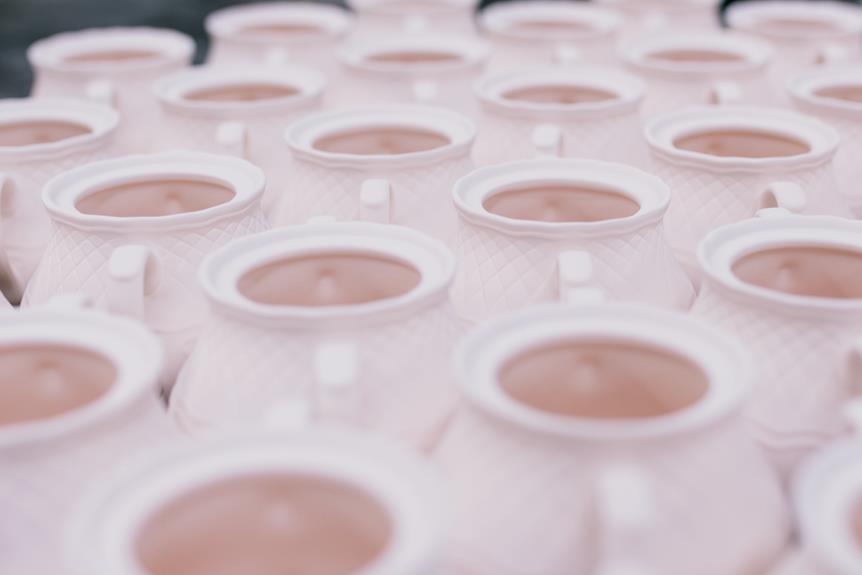Wondering which glue is best for ceramics?
Did you know that ceramics, when properly adhered, can withstand temperatures up to 3,000°F?
Choosing the right adhesive is crucial for ensuring the longevity and strength of your ceramic projects.
In this guide, you'll explore the characteristics of ideal ceramic glues and compare popular options like epoxy resin, cyanoacrylate (super glue), polyurethane, and silicone adhesives.
Whether you're repairing a cherished ceramic vase or crafting a new mosaic masterpiece, understanding the best glue for ceramics will give you the confidence to tackle any project with ease.
Let's dive in and find the perfect adhesive for your ceramic creations.
Key Takeaways
- There are various types of ceramic adhesives available, each with unique properties and best uses.
- Surface preparation is crucial before applying any adhesive to ensure proper bonding.
- Epoxy resin is a strong and reliable adhesive for ceramics, providing heat and water resistance.
- Cyanoacrylate (Super Glue) is a quick and secure bonding option for ceramics, offering immediate bonding in seconds.
Types of Ceramic Adhesives
When repairing ceramics, you'll want to consider the different types of ceramic adhesives available to ensure a strong and lasting bond. There are various ceramic adhesives on the market, each with its own unique properties and best uses.
Before applying any adhesive, surface preparation is crucial. Ensure that the surfaces to be bonded are clean, dry, and free of any dust or debris.
When it comes to application techniques, the type of adhesive you choose will determine the best approach. Some adhesives work best when applied to both surfaces, left to dry, and then bonded together, while others require immediate bonding after application. Understanding the specific instructions for the adhesive you select is essential for a successful repair.
Additionally, surface preparation plays a significant role in the effectiveness of the adhesive. Roughening the surfaces to be bonded can create a better grip for the adhesive, especially on smooth or glazed ceramics. Some adhesives may also require primers or activators to enhance adhesion to the ceramic surfaces.
Taking the time to understand the application techniques and surface preparation for your chosen adhesive will help you achieve a durable and reliable bond for your ceramic repairs.
Characteristics of Ideal Ceramic Glue
The ideal ceramic glue should exhibit strong adhesion to ceramic surfaces. When searching for the best adhesive for ceramics, keep in mind the following characteristics of an ideal ceramic glue:
- Ideal Adhesion: The perfect ceramic glue should form a strong and durable bond with ceramic surfaces, ensuring that the repaired item remains intact even under stress or pressure. Look for adhesives specifically designed for use with ceramics, as they're formulated to provide the ideal adhesion strength needed for this material.
- Durability: An ideal ceramic glue should offer long-lasting durability, with the ability to withstand exposure to various environmental factors such as moisture, heat, and cold. This ensures that the repaired ceramic item maintains its structural integrity over time, without the need for frequent reapplication or repairs.
- Versatility: Look for a ceramic glue that's versatile and can be used for a wide range of ceramic items, from delicate pottery to durable tiles. A versatile adhesive provides the convenience of being able to use the same product for different ceramic repair or bonding needs.
Epoxy Resin for Ceramics
Looking for a strong and reliable adhesive for your ceramic projects? Epoxy resin might be just what you need.
It creates a powerful bond that can withstand heat and water, making it ideal for ceramic items like mugs or vases.
Not to mention, its clear and durable finish ensures that your ceramic pieces will look impeccable even after being glued back together.
Strong Bond for Ceramics
For bonding ceramics, epoxy resin provides a strong and durable adhesive solution. When working with epoxy resin for ceramics, consider the following:
- Surface Preparation:
Thoroughly clean the ceramic surfaces to remove any dirt, dust, or grease that could interfere with the bonding process.
Roughen the surfaces with sandpaper to create a better mechanical bond for the epoxy resin.
- Mixing and Application:
Follow the manufacturer's instructions for mixing the epoxy resin components to ensure a proper chemical bond.
Apply the epoxy resin evenly to both surfaces using a small brush or applicator, ensuring full coverage for a strong bond.
- Clamping and Curing:
Use clamps to hold the bonded pieces together firmly during the curing process to achieve maximum strength.
Heat and Water-Resistant
To ensure heat and water resistance when using epoxy resin for ceramics, thoroughly mix and apply the adhesive according to the manufacturer's instructions. Epoxy resin provides high temperature resistance and forms a strong chemical bond with ceramics, ensuring long-term durability and impact resistance.
When mixing the epoxy resin, measure and mix the components precisely to ensure proper curing and maximum strength. Apply the adhesive evenly to both surfaces, pressing the pieces together firmly to create a secure bond. Once bonded, allow the epoxy to cure fully before subjecting the ceramics to heat or water.
Following these guidelines will help you achieve a reliable and durable bond that withstands high temperatures and resists water, making epoxy resin an excellent choice for heat and water-resistant ceramic repairs and projects.
Clear and Durable Finish
For a clear and durable finish on ceramics, opt for epoxy resin, which provides a long-lasting and transparent protective coating.
When using epoxy resin for ceramics, consider the following:
- Application: Ensure the surface is clean and dry before applying the epoxy resin to achieve a crystal-clear finish.
- Curing Time: Allow sufficient time for the epoxy resin to cure properly to maximize its durability and strength.
- Long Lasting Adhesion: Epoxy resin offers exceptional adhesion, creating a strong bond that withstands wear and tear, ensuring the longevity of the clear finish.
Cyanoacrylate (Super Glue) for Ceramics
Looking to fix your broken ceramic pieces quickly and securely?
Cyanoacrylate, also known as super glue, offers a strong bond in seconds, making it a versatile and fast-acting option for ceramic repairs.
Whether it's a delicate figurine or a functional ceramic item, super glue can provide a reliable and durable fix in no time.
Strong Bond in Seconds
For bonding ceramics quickly and effectively, cyanoacrylate (super glue) is the best option. It offers quick curing and a long-lasting hold, making it ideal for a variety of ceramic bonding needs. Here's why you should consider using cyanoacrylate for ceramics:
- Immediate Bonding: Cyanoacrylate super glue bonds ceramics in a matter of seconds, allowing for efficient and rapid repairs or assembly.
- *Precision Application*: Its fast-curing nature enables precise positioning of ceramic pieces before the bond sets, ensuring accurate and clean results.
- *Durable Strength*: Once cured, cyanoacrylate forms a strong and resilient bond that can withstand the rigors of everyday use, providing a reliable and long-lasting hold for your ceramic projects.
Cyanoacrylate's quick action and durable adhesion make it an excellent choice for achieving a strong bond in seconds when working with ceramics.
Versatile and Fast-Acting
When bonding ceramics, cyanoacrylate super glue stands out as a versatile and fast-acting adhesive option. Its quick application and long-lasting hold make it an ideal choice for various ceramic projects. This type of glue is effective on various surfaces, providing a strong bond in seconds. Additionally, it offers easy cleanup, making it convenient to work with. Below is a table highlighting the key advantages of using cyanoacrylate super glue for ceramics:
| Advantages | Description |
|---|---|
| Quick Application | Bonds ceramics rapidly |
| Long Lasting Hold | Provides a durable and strong bond |
| Effective on Various Surfaces | Works well on different types of ceramic surfaces |
| Easy Cleanup | Allows for convenient and hassle-free cleanup |
Cyanoacrylate super glue proves to be a reliable and efficient adhesive for a wide range of ceramic applications.
Polyurethane Adhesive for Ceramics
When bonding ceramics, you should consider using polyurethane adhesive for its strong and durable hold. Polyurethane vs Epoxy: Unlike epoxy, polyurethane adhesive doesn't require mixing, making it easier to use. Polyurethane also has a longer working time, allowing for more precise application.
Best Application Techniques: Before applying polyurethane adhesive, ensure the ceramic surfaces are clean and dry. Apply a thin, even layer of the adhesive to one surface and press the pieces together firmly. Use clamps or tape to hold the pieces in place while the adhesive sets. Wipe away any excess adhesive with a clean cloth. Allow the bond to cure fully for the recommended time, usually 24 hours.
Polyurethane adhesive works well for ceramics due to its flexibility, impact resistance, and waterproof properties. Its ability to bond porous materials makes it ideal for ceramics, providing a strong and long-lasting bond. With the right application techniques, polyurethane adhesive can effectively join ceramic pieces, making it a top choice for ceramic bonding projects.
Silicone Adhesive for Ceramics
Consider using silicone adhesive for bonding ceramics due to its excellent flexibility and resistance to extreme temperatures, complementing the previous discussion of polyurethane adhesive for ceramics. Silicone adhesive is a popular choice for ceramic applications due to its versatility and durability. When using silicone adhesive for ceramics, it is important to consider the application techniques and best practices to ensure a strong and reliable bond.
| Application Techniques | Best Practices |
|---|---|
| Clean the ceramic surfaces thoroughly before applying the adhesive. | Ensure that the ceramic surfaces are free of dust, grease, and any other contaminants that may affect the bonding. |
| Apply the silicone adhesive evenly and with consistent pressure. | Use a caulking gun or precision applicator to control the flow of the adhesive and achieve an even coat. |
| Allow sufficient curing time for the adhesive to set. | Follow the manufacturer's instructions regarding the curing time and conditions for the best results. |
| Check the compatibility of the silicone adhesive with different ceramic surfaces. | Some silicone adhesives may be specifically formulated for certain types of ceramics, so it is important to ensure compatibility before application. |
Silicone adhesive is compatible with a wide range of ceramic surfaces, including porcelain, earthenware, and stoneware. By following the recommended application techniques and best practices, you can achieve strong and lasting bonds when using silicone adhesive for ceramics.
Comparison of Ceramic Glue Strengths
You can assess the strength of ceramic glues by conducting comparative adhesive tests using different types of ceramic materials. This will give you a clear understanding of how well each type of glue performs under specific conditions.
When comparing ceramic glue strengths, consider the following:
- Adhesive Bonding Techniques
- Evaluate the effectiveness of various adhesive bonding techniques such as surface preparation, application method, and curing process. Different techniques can significantly impact the strength of the adhesive bond.
- Ceramic Glue Application
- Explore how different ceramic glues perform when applied to various ceramic surfaces. Some glues may excel with smooth, glazed ceramics, while others may show better results with rough, unglazed ceramics.
- Material-Specific Testing
- Test the glues on different types of ceramic materials, such as porcelain, earthenware, or stoneware. This will help you determine which glue is best suited for a particular type of ceramic, ensuring optimal adhesive strength and durability.
Frequently Asked Questions
Can Ceramic Glue Be Used to Repair Outdoor Ceramic Items Exposed to Extreme Temperatures and Weather Conditions?
For outdoor ceramic items exposed to extreme temperatures and weather conditions, it's crucial to use a ceramic glue that offers outdoor durability and weather resistance. When repairing ceramics, ensure the glue can withstand these challenges for lasting results.
Is There a Specific Type of Ceramic Glue That Is Food-Safe and Can Be Used to Repair Ceramic Kitchenware?
For food-safe ceramic kitchenware repair, the best glue is an epoxy or cyanoacrylate adhesive. These options bond well with ceramics and are safe for use with items that come into contact with food.
Can Ceramic Glue Be Used to Bond Different Types of Ceramics, Such as Porcelain and Stoneware?
Yes, ceramic glue alternatives can bond different types of ceramics, like porcelain and stoneware. However, when bonding non-ceramic materials, it's essential to choose a specialized adhesive designed for the specific materials being joined.
Are There Any Special Considerations or Techniques for Using Ceramic Glue on Delicate or Finely Detailed Ceramic Items?
When using ceramic glue on delicate ceramics, take extra care to avoid excess glue that could obscure fine details. Repairing fine details on ceramics requires precision and patience to ensure a seamless bond without damaging the delicate areas.
Is There a Ceramic Glue That Is Specifically Designed for Repairing Ceramic Tiles and Other Large, Flat Ceramic Surfaces?
When repairing ceramic tiles or large surfaces, consider using a ceramic glue designed for sculptural ceramics. For delicate or finely detailed items like figurines, a specialized ceramic glue formulated for intricate repairs may be more suitable.
- What Is Pochampally Ikat? a Journey to India’s Silk City - June 27, 2025
- What Is Pochampally Ikat? a Journey to India’s Silk City - June 27, 2025
- What Is Pochampally Ikat? a Journey to India’s Silk City - June 27, 2025







